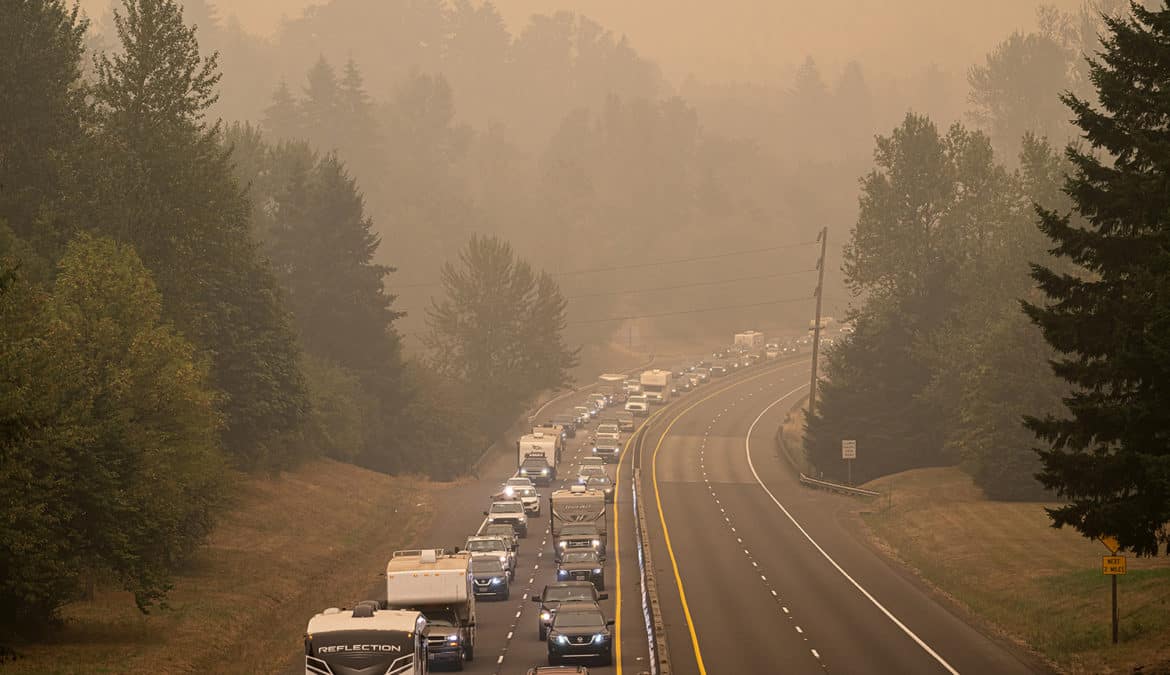Wildfires fueled by strong winds are ravaging western Oregon, destroying small towns served by electric cooperatives, forcing 500,000 people to flee their homes and spurring four co-ops to turn off power at night to avoid sparking new blazes.
More than 30 fires have burned through more than a million acres and killed at least 10 people, according to state officials. Oregon Gov. Kate Brown said at a news conference that the disaster has the potential to be “the greatest loss of human lives and property due to wildfires in our state’s history.”
“I don’t know of anybody who doesn’t have a bag packed in western Oregon, including my family,” said Ted Case, executive director of the Oregon Rural Electric Cooperative Association in Wilsonville. “Everybody is on high alert.”
Case decided to evacuate his home with his family Friday as thick smoke filled his neighborhood from a fire about 15 miles away.
“It looks like Mars outside right now,” he said. “Everything is just red.”
Case said the wildfires have hit four of the state’s 18 co-ops hardest: Consumers Power Inc. in Philomath, Lane Electric Cooperative in Eugene, Blachly-Lane Electric Cooperative in Junction City and West Oregon Electric Cooperative in Vernonia. They have had to perform public safety power shutoffs at night to prevent igniting more fires.
“For those of you who appreciated the fire mitigation efforts we have just made, thank you,” Blachly-Lane officials wrote on their website. “For those of you who didn’t understand the cause of the Public Safety Power Shutoff, we’ll do our best in the coming weeks and months to explain it. We don’t have to look too far to see the devastating effects of fire to communities like ours, and we believe that this is the responsible thing to do. Mother Nature bats last, as they say, and sometimes it’s a curveball.”
The fires or threat of fires caused outages to thousands of the four co-ops’ meters, but they were in the process of restoring them quickly and the number of outages continued to drop, Case said. Hundreds of power poles have been lost. In “one piece of good news out of a whole lot of bad,” Consumers Power saved a major substation by digging a trench around it so flames wouldn’t reach the equipment, he said.
“The fact that it’s still standing is a real victory,” Case said.
However, the tiny mountain town of Detroit, which Consumers Power serves, was destroyed in the huge Santiam Fire, leaving its 200-plus residents without homes.
“That town was just devastated,” Case said.
Blue River, a picturesque town of about 800 people served by Lane Electric, was also reduced to ash and rubble by the separate Holiday Farm fire.
As emergency crews focused on evacuating people and saving lives, the extent of property damage in many places had not yet been determined. Members of co-ops’ operations staff were among those evacuated from their homes.
The Oregon co-ops that haven’t been badly hurt have sent help to the four hardest-hit co-ops, but it’s difficult for them to do as much as they’d like, Case said.
“It’s a challenge just to move around,” he said. “There’s just no ability to access mountain roads. Right now, it’s the fog of war. We just don’t know the extent of damage.”
When the time for recovery comes, help from those other co-op crews will be badly needed, he said.
“It’s going to be an incredible job to rebuild those systems,” Case said.
Meanwhile, farmers are filling the roads with trailers as they try to save goats, horses and other animals from the flames.
“The combination of the strong easterly winds and the dry weather make these fires difficult to contain,” Case said. “The flames are coming at you like a raging river. We still don’t know how many people didn’t make it out alive.”
Erin Kelly is a staff writer at NRECA.

